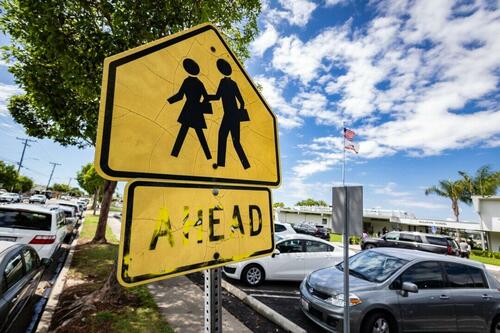
California Public Schools Are Losing Kids While Special Interests Profit
New numbers from the California Department of Education show a continued drop in public school enrollment in the 2024–2025 school year. Despite fewer students, TK-12 education spending continues to increase, begging the question of whether taxpayers are getting value for money.
The 5.8 million students counted for the just-concluded school year represents a reduction of 31,000 from 2023–2024 and 380,000 (or 6 percent) from before the pandemic. But the drop in traditional public school enrollment is even worse than these headline numbers suggest. The totals include charter schools which added 75,000 students since the 2018–19 school year.
Netting out charters yields an enrollment drop of 8 percent, and this is despite the fact that a new grade, Transitional Kindergarten, was added during the period.

However, as Marc Joffe reports for The Epoch Times, the declining student population required much more taxpayer money. According to state budgets, total K-12 educational funding rose from $97.2 billion in 2018–19 to $133.8 billion in 2024–25. That represents a 10 percent increase even after adjusting for inflation. And that only represents operating costs. Voters approved over $40 billion in local K-12 school bonds last year as well as a state school bond which will provide matching funds for school construction.
While some capital expenditure is needed to renovate older school buildings, we should rarely need to add new buildings in this time of declining enrollment. Yet California continues to build new schools, sometimes at staggering cost. In Los Angeles County, a new 31-acre facility replacing Compton High was recently completed at a cost of $225 million to accommodate about 1,400 students. In Alameda County, Dublin Unified’s new Emerald High School is costing $374 million. Although the school has a capacity of 2,500 students, it remains to be seen how much of that capacity will be used.
To save money, districts suffering declining enrollment should consolidate low-attendance schools, but school closures often meet heavy stakeholder resistance. In the Los Angeles Unified School District (LAUSD) alone, three dozen schools saw enrollment fall below 200 between 2018–19 and 2024–25, making them good candidates for consolidation.
But when asked about school consolidation, LAUSD’s Board President said, “I’m kind of fearing talking about it, because people are just going to go berserk,” according to education news website The 74.
That’s unfortunate, because low enrollment schools cannot spread their fixed costs such as administrator salaries and utilities across a large number of students, and because they lack the critical mass to offer sports and other extracurricular activities.
California’s high education spending does not produce strong learning outcomes. Despite per pupil expenditures well above the national average, California fourth and eighth graders perform below the national average on standardized math and reading exams. Utah outperforms California on all national comparisons even though its per pupil spending is 45 percent lower, and even Mississippi, America’s poorest state, is outperforming California on some of the tests.
Instead of helping students, California’s extra education spending seems to mostly benefit special interests such as unions, contractors, election consultants, and financial intermediaries.
While we normally hear about teacher unions, other categories of school employees have their own unions. At LAUSD, administrators, financial analysts, and even playground aides all bargain collectively and pay union dues. Unions have an incentive to maximize their membership (and thus their dues revenue), so they naturally oppose reforms that might lower headcounts or constrain employee compensation.
As a result, California’s overinvestment in school infrastructure is actively supported by a complex of service providers seeking to improve their bottom lines. Election consultants poll voters and craft ballot language to maximize the odds of school bonds. Financial advisors, bond underwriters, and construction contractors often contribute to school bond campaigns, thereby increasing their chances of getting new business.
Indeed, the California school construction industry has its own lobbying group in Sacramento, ironically named CASH, short for the Coalition for Adequate School Housing, which was involved in passing last year’s state school facilities bond measure, Proposition 2.
While unions and construction advocates couch their advocacy in terms of what’s good for pupils, the facts are clear: California is spending a lot of money to provide a middling education to a dwindling number of public school students.
Tyler Durden
Wed, 06/11/2025 – 18:30

 6 miesięcy temu
6 miesięcy temu











